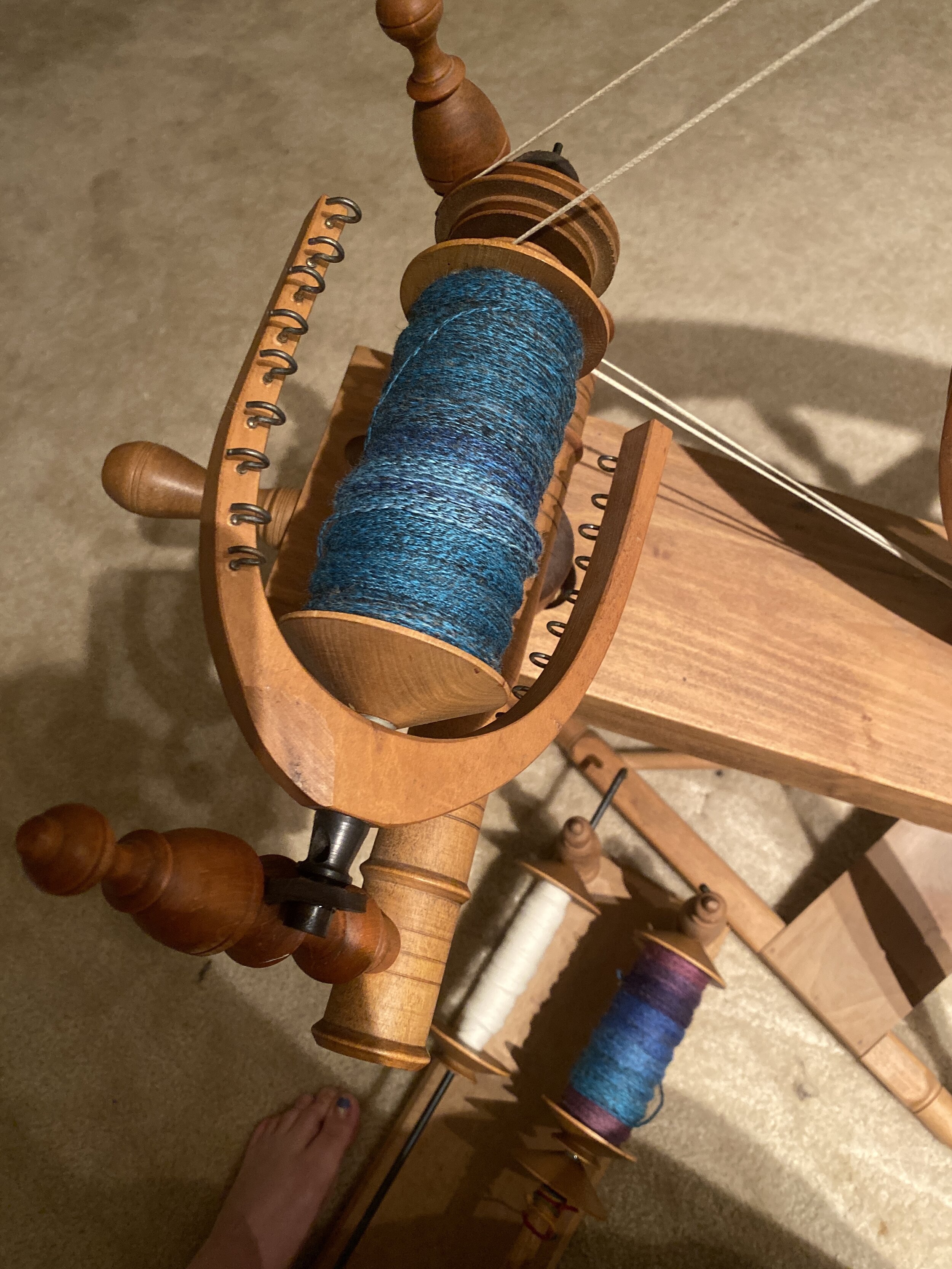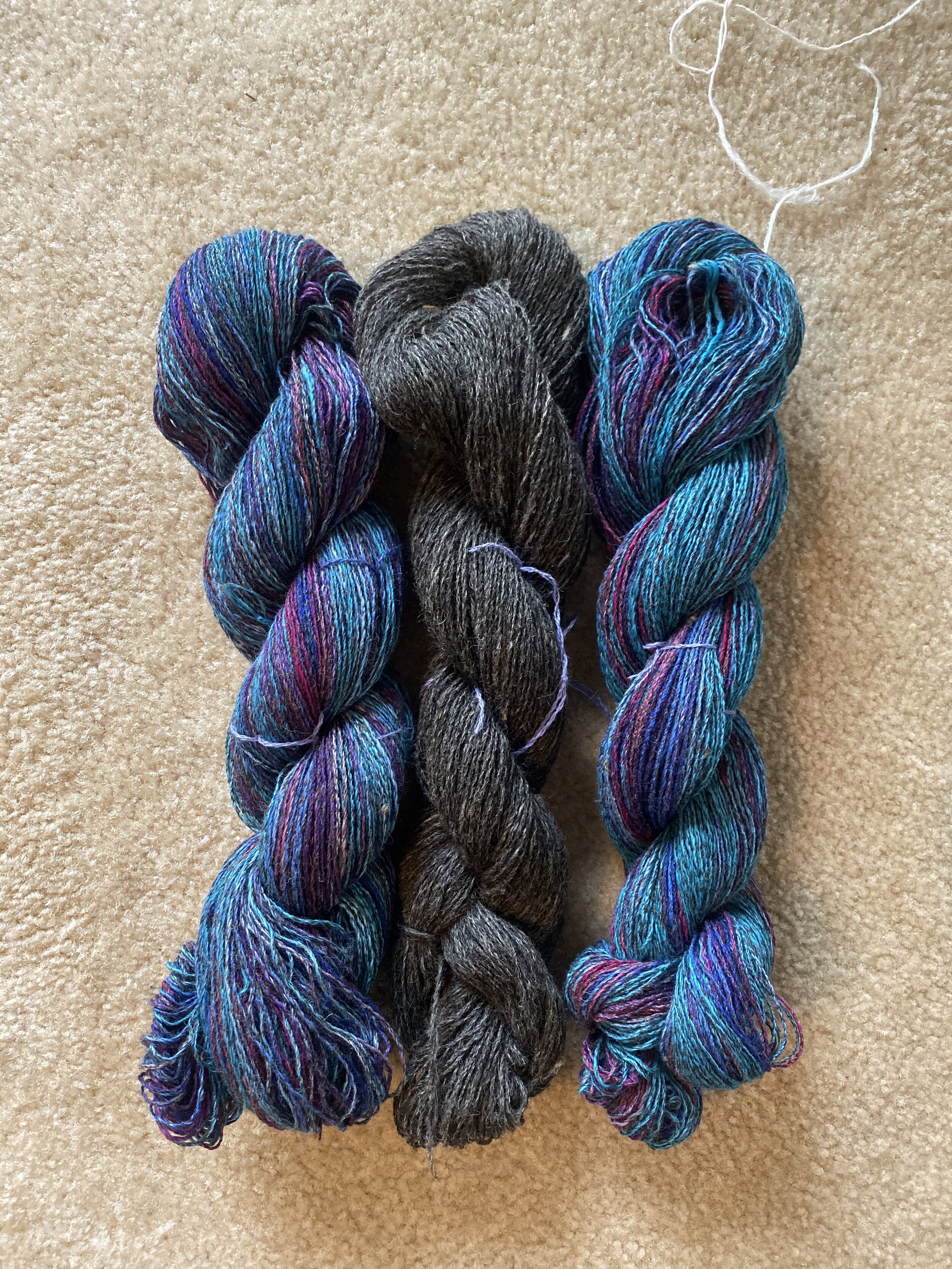The super fine alpaca/shetland/nylon singles
This yarn is the followup to the merino sock yarn from February. That time, I took two strands of singles made from the roving my mum dyed, plied them, and then did a three ply of that plied yarn. This time, I took the same dyed single, and did that initial two ply against a heathered grey single.
The grey is a blend of 40% aplaca (named Serious), 40% shetland wool (sheep’s name is Treysa), and 20% black nylon. My mum and I were given these two fleeces in exchange for a pair of socks, and blended it up with the plan to make sock yarn from it. That was in 2014…. it’s been sitting in a box on the shelf since then. I did start spinning some of it back when my mum sent me the blended bats, however I hadn’t spun much, and it was heavier than I wanted to use for plying against the dyed roving, so I spun up some super fine singles.
Dyed single on the bottom, grey single in the middle, and the two plied together (just the two ply) on top
The stuff was (is? I haven’t used it all up yet…) lovely to spin. We carded it in the grease, only alpacas don’t have grease, and I don’t think Shetlands are a super greasy breed, so there isn’t too much lanolin still in the fibers. Amazingly enough, what is there hasn’t gone tacky with time, and the fiber is just as wonderfully pleasant to spin as it was originally. It is a bit weird at times because the staple length of the different fibers and how much they stick to their similar type of fibers is quite different. The Shetland wool liked pulling along the other shetland fiber, and since it was lighter in color there are sometimes regions of lighter yarn. The nylon generally was quite well blended in, but occasionally there were what almost looked like very fine locks of it-little sections that had stayed together, that were about the width of one of my singles. I’d typically start at one end of a batt and have mostly shetland at the start, and then end at the other end, with lots of short fibers that were a mix of alpaca and nylon. If I were more worried about trying to make the yarn as consistent as possible, I’d break the batts up into smaller pieces before spinning, and hold the next piece alongside finishing the previous piece, to make sure that all regions had the same mix of fibers. I’m not that worried about it though.
As I mentioned above, I then plied this super fine grey against the dyed blue, using lots of twist so that it was far from balanced. You can sort of tell that from the picture, since the predominant color of the yarn is blue, not grey. I decided to use the grey in the first place for a few reasons. I liked the idea of having at least a little bit of nylon in the yarn, even though the first batch seems like it should be sturdy enough. I wanted the finished yarn to be a bit finer, so I needed a finer single to ply the blue against. I also didn’t want the dyed colors to get too muddy when plied against one another. For the first batch of yarn I forced the colors to line up every once in awhile, but that was going to be harder and harder to do as my supply of dyed singles decreased, and while the pink against the teal had turned out better than I’d expected, it still wasn’t my favorite.
The final step was to chain-ply the two ply into a six ply. I typically do all my spinning on my Ashford traditional, because I like spinning very fine, and I have the extra-super-fast-lace flyer adaption on my ashford. I can really get that thing going around quickly. For plying, I typically switch wheels though to my ‘country craftsman’ spinning wheel-a beautiful old fashioned Saxony style wheel, complete with distaff and big bobbins. It’s a double drive wheel, while my ashford is a single drive.




To go along with this yarn, I decided to ply up the thicker singles of grey that I’d spun back in 2014 and 2015. I had three partially filled bobbins, and wasn’t super interested in spinning more of it that weight (I’m thinking it will work well for heels and toes, and I’m so happy with how plying it against a dyed single went that I want to use the rest of the fiber for that-I have several other dyed rovings that I can repeat this with!). For this yarn, I decided that a 4 ply was about the right weight to match with my other six ply. (Did I mention that I spun that other grey single super fine?) So, I decided to do another cabled yarn, only this time I’d ply two plied yarns together, instead of using chain-plying to ply 3 plied yarns together.
In order to use all my singles, I ended up using a technique where you ball up the singles, and ply using both ends. This allowed me to turn all of the three bobbins of singles into a single bobbin of two ply yarn. I then balled up all of the two ply yarn, and cabled that. This technique of using both the outside of the ball and the center pull can lead to horrible knots (particularly with unbalanced yarn!), if you’re not careful, so I really like to do this all in one go, if at all possible. I had some struggles with my original singles, but the plied yarn behaved really nicely, and didn’t give me a moment of frustration. I’m not sure I’ve ever had this process go quite this smoothly before…
I think the resulting yarn is fairly well matched in size to the one with the dyed single, and I think they’ll work very nicely together in socks. I’m excited to cast on!